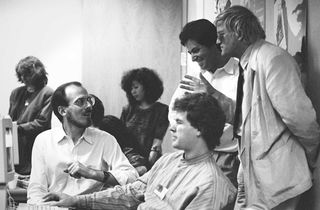How Photoshop changed the way we work
Lance Evans - who helped develop the software at its inception - recaps Photoshop's history to explain its effect on us all.

If there was just one computer graphics program that could make us all weep with utter love, that would be Photoshop. Not that there aren't many other jaw dropping programs around today, there are. And it's not that Photoshop was the first program in the world to do (mostly) what it did, as it wasn't.
So on Photoshop's 25th anniversary, we have to ask what was it that put it so far ahead of similar programs? This is a hard question to answer in a single article. But it all began with two brothers. While not nearly as famous as the Wright Brothers, for those of us in the graphic arts business, the Knoll brothers have probably had a much more meaningful impact on our daily lives. Yet too few people recognize their name.
Brothers in arms
Look quickly the next time Photoshop boots up, and you might catch the name Thomas Knoll, who along with his brother John, co-developed PS in their spare time during the late 1980's. Thomas is still actively working on the PS development team at Adobe today, and was the brother that started the program's development as part of his Ph.D. project entitled "processing of digital images".
John Knoll left PS development long ago, but at the time of its early development he had started working at a small effects house in Northern California called Industrial Light & Magic, as a motion control specialist. He was familiar with early digital effects work being done at ILM and could see where the industry was headed.

He is quoted as encouraging Thomas to continue, saying that "If you write it, I'll figure out how to make money with it." And he did. In fact it was through his ILM connection that an early incarnation of PS was used to help produce its first motion picture, James Cameron's "The Abyss".
But it was hardly smooth sailing for the brothers. They kept refining the program, and continually tried to sell it to one Silicon Valley company after another. In the end, collecting over 30 rejections along the way. They found a bit of success selling a limited license to scanner manufacturer BarneyScan, in a bundling deal. This netted a total of 200 sales.
In September of 1988 John made a presentation to a group that included Adobe co-founder John Warnock and Adobe Creative Director Russell Brown. After which Brown said to Warnock "We should buy this!" To which Warnock replied, "We are." The licensing deal was sealed by handshake some months later in 1989.
Get the Creative Bloq Newsletter
Daily design news, reviews, how-tos and more, as picked by the editors.

It was around this time that this author had the good fortune to be invited to work with a pre-release beta version of Photoshop, and directly with John Knoll who was busy expanding the program's capabilities and creating the powerful plugin architecture. I have fond memories of jotting off notes to John with requests, and getting a 'You've Got Mail' notification on my AOL mail a short while later with a note saying "Hey Lance, Give this new plugin a try and see if it does what you need. John" If memory serves, it usually did.
I have fond memories of getting a 'You've Got Mail' notification on my AOL from John
Photoshop had the distinction of being the first application to be represented by Adobe that was purchased. All of their previous offerings, the Postscript language, postscript typefaces, and their Adobe Illustrator software, were all developed in-house. Photoshop was not only a significant departure from their past business model, but being pixel rather than vector based meant it was also a big departure from every other product they Adobe had.

Next page: more on how Photoshop changed the way we work...

Thank you for reading 5 articles this month* Join now for unlimited access
Enjoy your first month for just £1 / $1 / €1
*Read 5 free articles per month without a subscription

Join now for unlimited access
Try first month for just £1 / $1 / €1
The Creative Bloq team is made up of a group of design fans, and has changed and evolved since Creative Bloq began back in 2012. The current website team consists of eight full-time members of staff: Editor Georgia Coggan, Deputy Editor Rosie Hilder, Ecommerce Editor Beren Neale, Senior News Editor Daniel Piper, Editor, Digital Art and 3D Ian Dean, Tech Reviews Editor Erlingur Einarsson, Ecommerce Writer Beth Nicholls and Staff Writer Natalie Fear, as well as a roster of freelancers from around the world. The ImagineFX magazine team also pitch in, ensuring that content from leading digital art publication ImagineFX is represented on Creative Bloq.
